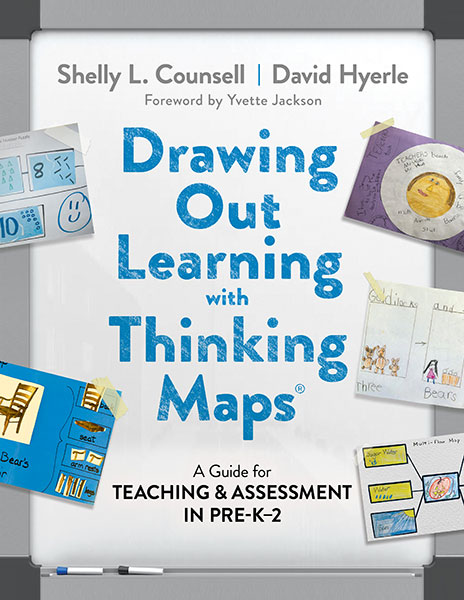
 Shelly L. Counsell is a retired associate professor of early childhood education, an early childhood consultant, and an Early Years Columnist with NSTA’s Science & Children. David Hyerle is a bestselling author, developer of the Thinking Maps® model, and president of Thinking Schools International. Together they are the authors of Drawing Out Learning With Thinking Maps®: A Guide for Teaching and Assessment in Pre-K–2.
Shelly L. Counsell is a retired associate professor of early childhood education, an early childhood consultant, and an Early Years Columnist with NSTA’s Science & Children. David Hyerle is a bestselling author, developer of the Thinking Maps® model, and president of Thinking Schools International. Together they are the authors of Drawing Out Learning With Thinking Maps®: A Guide for Teaching and Assessment in Pre-K–2.
Thinking Maps® (TMaps) is a visual-verbal-spatial language of eight fundamental cognitive skills and a metacognitive Frame of Reference. TMaps are used to support children’s rich synthesis of thinking processes, mental strategies, techniques, and knowledge, known as cognitive flexibility, which children need in order to investigate unknowns, show patterns of information, and express, build, and assess new knowledge.
In over 35 years of implementing TMaps through a whole school approach, we have observed 10 common misconceptions that educators frequently experience early on. Our new book, Drawing Out Learning With Thinking Maps®: A Guide to Teaching and Assessment in Pre-K–2 exemplifies how to resolve these issues by focusing on essential concepts, strategies, and materials as they pertain to preschool and primary grades.
Misconception 1: Thinking Maps look like a loose collection of “graphic organizers.”
Principle 1: Integrating different types of visual tools
Different types of visual tools (Hyerle: 1996, 2000, 2011), such as “task-specific” graphic organizers and open-ended Mind Mapping for pre-writing processes, suggest paper-and-pencil tasks to discuss and write key concepts, ideas, and mental relationships. We explain in our book that the eight fundamental cognitive processes that comprise TMaps have distinct visual forms that are used together across disciplines. TMaps engage generative and creative thinking, analytic and organizational structuring of content knowledge, as well as deep conceptual thinking and learning within units of study, topics, and themes with young children.
Misconception 2: Thinking Maps are a typical educational model using a hierarchy of sequential skills, from simple to complex.
Principle 2: A nonlinear language of cognitive processes and patterns
There is no sequential or hierarchical structure to the theory and practice of Thinking Maps as a language of cognition, much like how parts of speech generate relentlessly unique combinations and forms of expression. Our book describes and illustrates how the eight TMaps and Frame of Reference can be used individually or in an infinite array of combinations depending on, and according to, the content, concepts, and context of learning.
Misconception 3: Educational models like Bloom’s Taxonomy justify a “ladder” interpretation, emphasizing that educators should focus on content memorization before challenging learners with “high order” concepts and critical thinking.
Principle 3: Using Thinking Maps to promote critical thinking
The eight TMaps and the Frame of Reference are used in a spiraling fashion throughout the teaching-learning-assessment process. We demonstrate how each TMap’s unique and adaptive visual pattern is a tangible scaffold for understanding, organizing, analyzing, and applying content knowledge and information in ways that help young children make sense of their world.
Misconception 4: The eight Thinking Maps and the Frame of Reference are developmentally appropriate only for older learners who can understand how to use the maps at expert levels.
Principle 4: Thinking Maps are for all ages and can begin at any time
At its core, our book describes and illustrates how to use TMaps in developmentally appropriate ways to promote young children’s learning. For decades, cognitive scientists and psychologists including Jean Piaget established that these “mental operations”—including contextualizing, describing, comparing, categorizing, seriating, spatially reasoning, and causally reasoning—are present from birth, and used in increasingly complex ways throughout the lifespan. TMaps empower learners to verbalize their thinking using a specific cognitive process such as sequencing (beginning, middle, and end), and they further enable learners easily to see their own thinking patterns (rectangles and arrows showing the sequence).
Misconception 5: The Thinking Maps framework is most useful to those fluent in English, and is less useful to learners without a fully developed primary vocabulary and syntax.
Principle 5: Scaffolding second language acquisition
Thinking Maps have proven benefits and effectiveness with dual language learners due the visual scaffolding of early and second language development. Primary and second languages are developed as learners use TMaps, expanding their cognitive and critical thinking capacities simultaneously. Since the early 2000s, the program Path to Proficiency by Jane Buckner has demonstrated how Thinking Maps can be used to scaffold language learning while simultaneously improving fundamental cognitive processes. To avoid pigeonholing TMaps as a prewriting organizational tool, we recommend using a variety of supplemental materials (e.g., photos, drawings, objects) with emergent readers and writers.
Misconception 6: Thinking Maps primarily promote cognitive development, and have less impact on social-emotional development
Principle 6: Integrating cognitive, emotional, and social development
Learners of all ages need to process their emotions and social interactions. TMaps and the Frame of Reference allow for authentic engagement, cooperation, social-emotional learning, and self-reflection. Within a democratic learning community, TMaps can help children voice and act on their ideas with agency, which will help develop their identity as capable thinkers and scholars. This works because students and teachers alike can see the visual representations of the ideas being discussed, thus tangibly eliciting the critical, “I see what you mean!”
Misconception 7: With TMaps, there is a single, static graphic that always remains the same and is “filled in” by learners.
Principle 7: Expandable “graphic primitives”
Each of the eight Thinking Maps expands from a starting place, beginning with its own unique “graphic primitives”—for example a rectangle and arrow—that can be adapted to any sequence and any number in an unlimited array of patterns. These can be simple sequences, cycles, parallel processes, or feedback loops (in systems that are more complex). In the book, we discuss the power of beginning with these “graphic primitives” for developing a shift to fluency in every learner, from novice to expert. The earlier young children begin using TMaps, the more they become dynamic and flexible in ways to apply them.
Misconception 8: It does not matter what each TMap graphic pattern looks like visually. Furthermore, defining each cognitive process with a unique graphic may constrain creativity.
Principle 8: Consistent graphic representations
As a language, the consistent graphic for each TMap and Frame of Reference is essential for creative, adaptive use and effective communication within classrooms and across whole schools and districts. All languages have a consistent graphic code: think of alphabets, mathematical numbers and symbols, or even musical notation. While we offer multiple ways of creating TMaps with young children beyond the typical paper-and-pencil approach—for example using materials such as cut out shapes, yarn, and chenille wire—it is imperative to use the same graphic starting point for each map. This increases learners’ recognition, comprehension, and overall fluency while avoiding confusion or misinterpretation.
Misconception 9: Thinking Maps is an isolated short-term teaching tool for teachers’ “tool belt” rather than a long-term learner-centered framework used across disciplines.
Principle 9: Thinking Maps for “thinker-centered” fluency
Initially, educators are very motivated to use TMaps to improve their direct instructional practices that make thinking visible to students during cooperative learning and assessment. Curriculum directors recognize the utility of TMaps to design lesson plans with direct links to learning standards. The original intent of the Thinking Maps framework (and the whole school focus), as emphasized in our book, is for teachers to help all students develop as independent thinkers as well as cooperative learners who visually and verbally share, and actively discuss, their emerging ideas.
Misconception 10: Thinking Maps are solely “process writing” tools and not for use across the other disciplines.
Principle 10: Cross discipline transfer
As we discuss in great detail in our book, the Thinking Maps framework promotes children’s growth and learning across the developmental domains and content areas. For example, the processes of comparing and categorizing (using Double Bubble and Tree Maps, respectively) are relevant to mathematics, science, social studies, and language arts. Artistic expression, music appreciation, and physical education are enhanced when learners see these processes at play. TMaps is a language-verbal-spatial cognitive framework of visual patterns, and the disciplinary, interdisciplinary, and transdisciplinary thinking and learning it promotes happens daily as learners become more fluent in the transfer process. Content knowledge, concepts, relationships, vocabulary, and skills are enhanced, enriched, and expanded in each academic domain using TMaps, beginning in PreK and throughout grades K–12.

Drawing Out Learning With Thinking Maps®
A Guide for Teaching and Assessment in Pre-K–2
Shelly L. Counsell and David Hyerle
